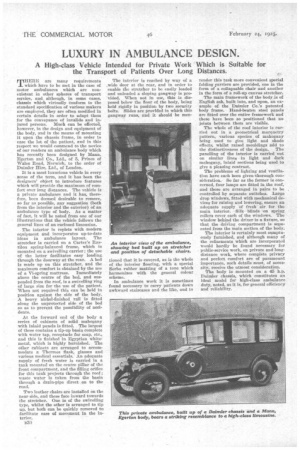LUXURY IN AMBULANCE DESIGN.
Page 14

If you've noticed an error in this article please click here to report it so we can fix it.
A High-class Vehicle Intended for Private Work Which is Suitable for the Transport of Patients Over Long Distances.
THERE are many requirements which have to be met in the ease of motor ambulances which are nonexistent in other spheres of transport service, and although, in some eases, chassis which virtually conform to the standard specification of various makers are employed, they are often modified in certain details in order to adapt them for the conveyance of invalids and injured persons. Much can be effected, however, in the design and equipment of the body, and in the means of mounting it upon the chassis frame, in order to ease the lot of the patient, and in this respect we would commend to the novice of our readers an ambulance body which has recently been designed by Mann, Egerton and Co., Ltd., of 5, Prince of Wales Road, Norwich, to the order of Daimler Hire, Ltd., of London.
It is a most luxurious vehicle in every sense of the term, and it has been the designers' object to introduce features which will provide the maximum of comfort over long distances. The vehicle is a private ambulance and it has, therefore, been deemed desirable to remove, so far as possible, any suggestion (both from the interior and the exterior) of an ambulance type of body. As a matter of fact, it will be noted from one of our illuatratians that the vehicle follows the general lines of an enclosed limousine.
The interior is replete with modern equipment and incorporates up-to-date ideas in ambulance layout. The stretcher is carried on a Carter's Rastilon spring-balanced frame, which is mounted on a swivelling carrier ; the use of the latter facilitates easy loading through the doorway at the rear. A bed is made up on this stretcher, and the maximum comfort is obtained by the use of a In-spring mattress. Immediately above the centre of the bed, and suspended from the roof, is a swivelling ring of large size for the use of the patient. When not required this can be held in position against the side of the body. A heavy nickel-finished rail is fitted along the unprotected side of the bed SO as to prevent the possibility of accidents.
At the forward end of the body a series of cabinets of solid mahogany with inlaid panels is fitted. The largest of these contains a tip-up basin complete with water tap, receptacle for soap, etc., and this is finished in Egyptian whitemetal, which is highly burnished. The other cabinets are arranged to accommodate a Thermos flask, glasses and various medical essentials. An adequate supply of fresh water is carried in a tank mounted on the centre pillar of the front compartment, and the filling orifice for this tank projects through the roof ; waste water is taken from the basin through a drain-pipe direct on to the road.
Two leather chairs are installed on the near side, and these face inward towards the stretcher. One is of the swivelling type, whilst the other is arranged to tip up, but both can be quickly removed to facilitate ease of movement in the interior. The interior is reached by way of a .wide door at the rear, and in order to enable the stretcher to be easily loaded and unloaded a sloping gangway is provided. When not in use, this is disposed below the floor of the body, being held rigidly in position by two security bolts. Slides are provided in which this gangway runs, and it should be men tioned that it is covered, as is the whole of the interior flooring, with a special Sorbo rubber matting of a tone which harmonizes with the general colour scheme.
In ambulance work it is sometimes found necessary to carry patients down awkward staircases and the like, and to render this task more convenient special folding carriers are provided, one in the form of a collapsable chair and another in the form of a roll-up canvas stretcher.
The main framework of the body is of English ash, built into, and upon, an example of the Daimler Co.'s patented body frame. Hand-beaten steel panels are fitted over the entire framework and these have been so positioned that no joints between them are visible.
The whole of the roof interior is carried out in a geometrical marquetry pattern, various species of mahogany being used to give light and shade effects, whilst raised mouldings add to the distinctiveness of the design. The panelling of the interior is carried out on similar lines in light and dark mahogany, inlaid sections being used to give a pleasing contrast.
The problems of lighting and ventilation have each been given thorough consideration. So far as the former is concerned, four lamps are fitted in the roof, and these are arranged in pairs to be controlled by separate switches. Large drop windows, fitted with mechanical devices for raising and lowering, ensure an adequate supply of fresh air for the Slain interior. Silk blinds -on spring rollers cover each of the windows. The window behind the driver is a fixture, so that the driting compartment is separated from the main section of the body.
The interior is certainly most sqmptuously furnished, and although many of the refinements which are incorporated would hardly be found necessary for public-service work, on private and longdistance work, where complete privacy and perfect comfort are of paramount importance, such details must, of necessity, receive the utmost consideration.
The body is mounted on a 45 h.p. Daimler chassis, which constitutes an ideal model for high-class ambulance duty, noted, as it is, for general efficiency and reliability.






























